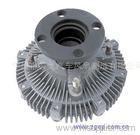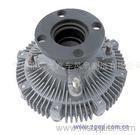|
K.G. (HK) Co., Ltd.
|
fan clutch
| Place of Origin: | Zhejiang, China (Mainland) |
|
|
|
| Add to My Favorites | |
| HiSupplier Escrow |
Product Detail
fan clutch
A fan clutch is a thermostatic device that exists as an integral component of certain automotive cooling systems. When the engine is cool or even at normal operating temperature, the fan clutch partially disengages the engine's mechanically-driven radiator cooling fan, generally located at the front of the water pump and driven by a belt and pulley connected to the engine's crankshaft. This saves power, since the engine does not have to fully drive the fan.
However, if engine temperature rises above the clutch's engagement temperature setting, the fan becomes fully engaged, thus drawing a higher volume of ambient air through the vehicle's radiator, which in turn serves to maintain or lower the engine coolant temperature to an acceptable level.
Most fan clutches are viscous or "fluid" couplings, combined with a bi-metallic sensory system similar to that in a thermostat.
Normally fan clutches are fairly reliable, but sometimes they fail. A common symptom of fan clutch failure is overheating at idle or in heavy traffic. Bad fan clutches can also cause poor performance of the car's air conditioning system because the fan also cools the air conditioner's condenser, which is directly in front of the radiator.
Another potential symptom of fan clutch failure (always drawing air at a high rate) in a cold weather climate is that the heating system blows lukewarm air never delivering sufficient hot air.



